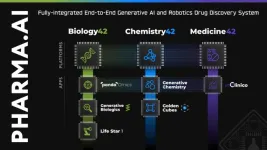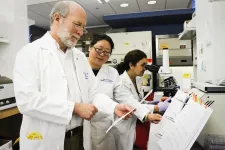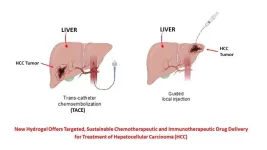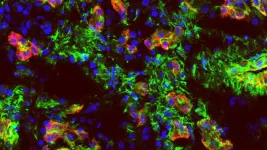(Press-News.org) Insilico Medicine (“Insilico”), an artificial intelligence (AI)-driven, clinical stage biotechnology company and leader in AI drug discovery platform technology, is hosting three webinars unveiling its latest technology breakthroughs Nov. 28-30, 2023. These new features are part of the expansion of the Company’s end-to-end Pharma.AI platform and include chat functionality, off-target screening tools, enhanced knowledge graphs and more. They represent major steps forward in the advancement of AI drug discovery.
The company is an early innovator in generative chemistry and biology and founder and co-CEO Alex Zhavoronkov, PhD first began publishing on the use of algorithms to find biomarkers for aging and disease in 2014, the same year Insilico was founded. By 2016, he had published the first peer-reviewed paper on generative chemistry, applying GANs to generate novel small molecules against cancer.
This early research gave rise to the company’s end-to-end platform – Pharma.AI – built on massive quantities of publicly available data and connecting that data to diseases and biological processes in order to identify novel targets, design new drugs, and predict the outcome of clinical trials.
This platform is now used by over 40 leading pharma companies, and has produced an internal pipeline of 31 therapeutic assets across 29 targets, including in cancer, fibrosis, and central nervous system diseases, with four in clinical stages. The Company’s lead drug, designed to treat idiopathic pulmonary fibrosis, is the first AI-designed drug for an AI-discovered target to reach Phase II trials with patients. Another drug developed by this platform – a potentially best-in-class USP1 cancer inhibitor for BRCA-mutated tumors – was recently licensed to Exelixis for $80m upfront and additional milestone and royalty payments.
Pharma.AI Platform Webinars:
PandaOmics 4.0 Webinar - On Nov. 28, 9am ET, Insilico will unveil the latest updates to ita AI target discovery engine, PandaOmics, including chat functionality, genetics related enhancements, indication prioritization and more. Online here: https://insilico.zoom.us/webinar/register/1016970290536/WN_zuuUT4poRvSNFxVWZTa9pw#/registration
Chemistry42 3.0 Webinar - On Nov. 29, 9am ET, Insilico will showcase new features for the Company’s generative AI drug design engine, Chemistry42, including ADMET optimization, a Golden Cubes feature which runs virtual kinases panels on databases of small molecules for off-target screening, custom reward modules, and more. Online here: https://insilico.zoom.us/webinar/register/1716970361580/WN_tm6N9ae2SuOcYxxBxjyMdg#/registration
InClinico 2.0 Webinar - On Nov. 30. 9am ET, Insilico will reveal the latest updates to the Compan’s AI clinical trial prediction tool, inClinico, including the predictive probability of success score, chat functionality, and network graph for target choice, among other features. Online here: https://insilico.zoom.us/webinar/register/8416970337545/WN_WzR6MJyISxWs9pW2cvl89A#/registration
About Insilico Medicine
Insilico Medicine, a global clinical stage biotechnology company powered by generative AI, is connecting biology, chemistry, and clinical trials analysis using next-generation AI systems. The company has developed AI platforms that utilize deep generative models, reinforcement learning, transformers, and other modern machine learning techniques for novel target discovery and the generation of novel molecular structures with desired properties. Insilico Medicine is developing breakthrough solutions to discover and develop innovative drugs for cancer, fibrosis, immunity, central nervous system diseases, infectious diseases, autoimmune diseases, and aging-related diseases. www.insilico.com
END
Insilico Medicine showcases latest AI drug discovery platform breakthroughs
2023-11-29
ELSE PRESS RELEASES FROM THIS DATE:
New astrophysics model sheds light on additional source of long gamma-ray bursts
2023-11-29
Cutting-edge computer simulations combined with theoretical calculations are helping astronomers better understand the origin of some of the universe’s most energetic and mysterious light shows — gamma-ray bursts, or GRBs. The new unified model confirms that some long-lasting GRBs are created in the aftermath of cosmic mergers that spawn an infant black hole surrounded by a giant disk of natal material.
Astronomers previously thought that black holes that generate long GRBs typically form when massive ...
Brain scans of former NFL athletes show a repair protein in place long after initial injury
2023-11-29
FOR IMMEDIATE RELEASE
In a new study using brain scans of former NFL athletes, Johns Hopkins Medicine researchers say they found high levels of a repair protein present long after a traumatic brain injury such as a concussion takes place. The repair protein, known as 18 kDa translocator protein (TSPO), is known to be present in the brain at high levels in the immediate aftermath of brain injury as part of the inflammatory response and to facilitate repair. The new findings, published Oct. 30 in JAMA Network Open, suggest that brain injury and repair processes persist for years after players end collision sports careers, and lead to long-term cognitive ...
Long-live quantum entanglement goes to distance
2023-11-29
Quantum technologies are currently maturing at a breath-taking pace. These technologies exploit principles of quantum mechanics in suitably engineered systems, with bright prospects such as boosting computational efficiencies or communication security well beyond what is possible with devices based on today’s 'classical' technologies. As with classical devices, however, to realise their full potential, quantum devices will need to be networked. In principle, this can be done using the fibre-optic networks employed for classical telecommunications. But practical implementation requires that the information ...
To build better tuberculosis vaccines, Saint Louis University researchers develop a new model by leveraging an old vaccine
2023-11-29
ST. LOUIS – Each year, tuberculosis (TB) kills more people than any other infectious disease, falling out of the top spot only temporarily during the COVID-19 pandemic.
Despite TB’s wide reach and some lost progress during the COVID-19 pandemic, researchers believe it is possible to eradicate TB through advances in vaccine development and public health. To cross the finish line, scientists must find ways to test new vaccines rapidly to prevent TB infections more effectively.
In a paper published in the Journal of Infectious Diseases, Daniel Hoft, M.D., Ph.D., ...
Improving our understanding of the effects of PFOS on fish
2023-11-29
Two papers recently published in Environmental Toxicology and Chemistry have made important advancements toward understanding the effects of perfluorooctane sulfonate (PFOS) on aquatic life, especially fish. Zebrafish had been identified in a previous study of limited scope as being among one of the most sensitive aquatic species to PFOS, and the results of that limited-scope study have influenced PFOS water quality criteria derived by some regulatory agencies, including the Australian Environmental Protection Agency (EPA).
Kurt Gust and ...
Enhanced treatment of liver carcinoma with a drug-eluting hydrogel
2023-11-29
(LOS ANGELES) – November 29, 2023 - Scientists from the Terasaki Institute for Biomedical Innovation (TIBI) have developed an injectable or catheter-administered hydrogel with enhanced capabilities for treating hepatocellular carcinoma (HCC), a deadly form of liver cancer. As described in their recent publication in Advanced Functional Materials, this drug-eluting hydrogel can provide sustained, pH-dependent drug co-delivery and has capabilities for promoting anti-tumor immune responses. This reduces tumor cell proliferation and growth and offers a more efficient means of enabling tumor cell death.
Worldwide, HCC is a leading cause of ...
Applying semiconductor manufacturing principles to optoelectronic devices
2023-11-29
Optoelectronics detect or emit light and are used in a variety of devices in many different industries. These devices have historically relied on thin transistors, which are small semiconductors that control the movement of electrons and photons, made out of graphene and other two-dimensional materials. However, graphene and these other materials often have problems with band gap opening and other shortcomings that have researchers searching for an alternative.
When treated with a method called the ...
The role of marketing in disrupted health care markets: It’s time to move beyond conventional strategies to account for new actors, roles, and exchanges
2023-11-29
Researchers from Duke University, University of New South Wales, University of Wisconsin, and University of Washington published an editorial for the Journal of Marketing that calls for marketing to tackle the challenges and opportunities in dynamic contemporary health care markets.
The editorial, introducing a special issue on “Marketing in the Health Care Sector” for the Journal of Marketing, is titled “Marketing in the Health Care Sector: Disrupted Exchanges and New Research Directions” and is authored by Christine Moorman, Harald J. van Heerde, C. Page Moreau, and Robert W. Palmatier. The special issue ...
Can we crack this cancer’s immune response?
2023-11-29
Recent findings at Cold Spring Harbor Laboratory (CSHL) shine a new light on pancreatic cancer.
More than 90% of pancreatic cancer cases are attributed to an aggressive, deadly form of the disease called pancreatic ductal adenocarcinoma, or PDAC. Researchers have a poor understanding of how our immune system interacts with PDAC. So, coming up with treatments is tricky. It’s thought patients do not show a natural immune response to the cancer because the tumor environment somehow prevents that response. Many are unconvinced that PDAC ...
Building blocks for life could have formed near new stars and planets
2023-11-29
While life on Earth is relatively new, geologically speaking, the ingredients that combined to form it might be much older than once thought. According to research published in ACS Central Science, the simplest amino acid, carbamic acid, could have formed alongside stars or planets within interstellar ices. The findings could be used to train deep space instruments like the James Webb Space Telescope to search for prebiotic molecules in distant, star-forming regions of the universe.
It has long been hypothesized that one of the building blocks for life, amino acids, could have formed during reactions in the “primordial ...







